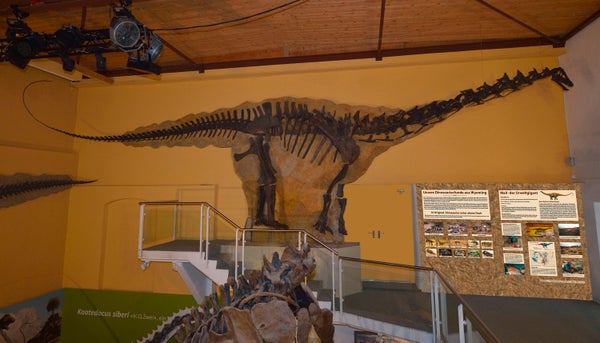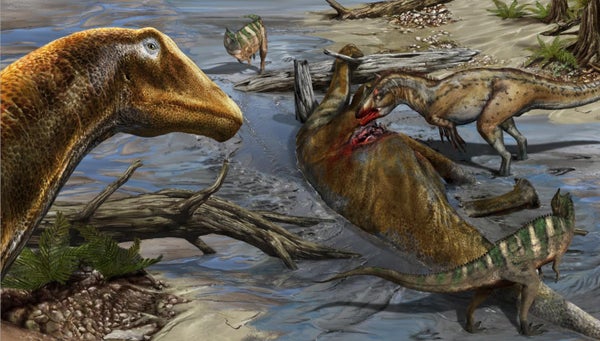This article was published in Scientific American’s former blog network and reflects the views of the author, not necessarily those of Scientific American
A new species of dinosaur is named about every two weeks. That's the latest statistic for the breakneck speed of dinosaur paleontology these days, but the announcements aren't evenly spread. Some weeks there will be no new dinosaurs at all and others you'll be flooded by an array of novel names. That's what happened earlier this month. On the same day we met Vouivria, another huge herbivore marched onto the scene.
The new dinosaur has a tangled taxonomic background. Way back in 1902, fossil hunter William Utterback found a sauropod skeleton near Sheridan, Wyoming. Paleontologist William Holland thought it was a Diplodocus, and in 1924 named it as a new species - Diplodocus hayi. In 2015, however, paleontologist Emanuel Tschopp and colleagues concluded that this dinosaur was something significantly different and gave the dinosaur a new name. The fossil became Galeamopus hayi, and now, on the basis of additional specimens, Tschopp and colleague Octávio Mateus have proposed there was another species of Galeamopus trundling around the Jurassic. They've named it Galeamopus pabsti.
The features that separate the two species are slight. They include a canal that runs across a jaw bone, a groove down the back of the skull, and robust arm bones, among other things. But if these differences hold up, that means as 13 different species of diplodocid dinosaurs have been excavated from the upper part of North America's Morrison Formation - the same beds that have given us Apatosaurus, Diplodocus, Barosaurus, and more.
How could so many similar sauropods have been present so close to each other in space and time? While the Late Jurassic sauropod spike is real, it's important to remember the timing. The whole of the Morrison Formation spans about 10 million years and the upper part, the Brushy Basin Member, represents about two million years. That's still a long time, especially when those various sauropods were living in different places across western North America. And even when these dinosaurs are found in the same spot, they are not found in the same abundance. Some are more common than others, hinting that there's far more to the ecology of these dinosaurs than we presently understand. Naming them is a good first step, but understanding how they lived is a Brontosaurus-sized task that's still underway.

A mount of Galeamopus. Credit: moeckliurs@bluewin.ch
On supporting science journalism
If you're enjoying this article, consider supporting our award-winning journalism by subscribing. By purchasing a subscription you are helping to ensure the future of impactful stories about the discoveries and ideas shaping our world today.
Fossil Facts
Name: Galeamopus pabsti
Meaning: Galeamopus, meaning "need helmet", was named in a previous paper. The species name pabsti is after Pen Pabst, who created the skull reconstruction for this dinosaur.
Age: Jurassic, about 152 million years ago.
Where in the world?: Wyoming and Colorado, USA.
What sort of organism?: A sauropod related to Diplodocus.
How much of the organism’s is known?: A skeleton including a partial skull, vertebrae, elements of the limbs, shoulder girdle, and an additional partial skull.
Reference:
Tschopp, E., Mateus, O. 2017. Osteology of Galeamopus pabsti sp. nov. (Sauropoda: Diplodocidae), with implications for neurocentral closure timing, and the cervico-dorsal transition in diplodocids. PeerJ. doi: 10.7717/peerj.3179
Previous Paleo Profiles:
The Light-Footed Lizard The Maoming Cat Knight’s Egyptian Bat The La Luna Snake The Rio do Rasto Tooth Bob Weir's Otter Egypt's Canine Beast The Vastan Mine Tapir Pangu's Wing The Dawn Megamouth The Genga Lizard The Micro Lion The Mystery Titanosaur The Echo Hunter The Lo Hueco Titan The Three-Branched Cicada The Monster of Minden The Pig-Footed Bandicoot Hayden's Rattlesnake Demon The Evasive Ostrich Seer The Paradoxical Mega Shark The Tiny Beardogs The Armored Fish King North America's Pangolin The Invisible-Tusked Elephant The Mud Dragon The Spike-Toothed Salmon The Dream Coast Crocodile Buriol's Robber Ozimek's Flyer The Northern Naustoceratopsian The High Arctic Flyer The Tomatillo From the End of the World The Short-Faced Hyena The Mighty Traveler from Egg Mountain Keilhau's Ichthyosaur Mexico's Ancient Horned Face Mauricio Fernández's Plesiosaur New Zealand's Giant Dawn Penguin The Orange Sea Lion Mongolia's Ginkgo Cousin The Geni River Frog Isabel Berry's Dinosaur The Whale Caiman The Moab Lizard Yang Zhongjian's Lizard The Little Anubis The Shuangbai Lizard The Wyvern Dinosaur
